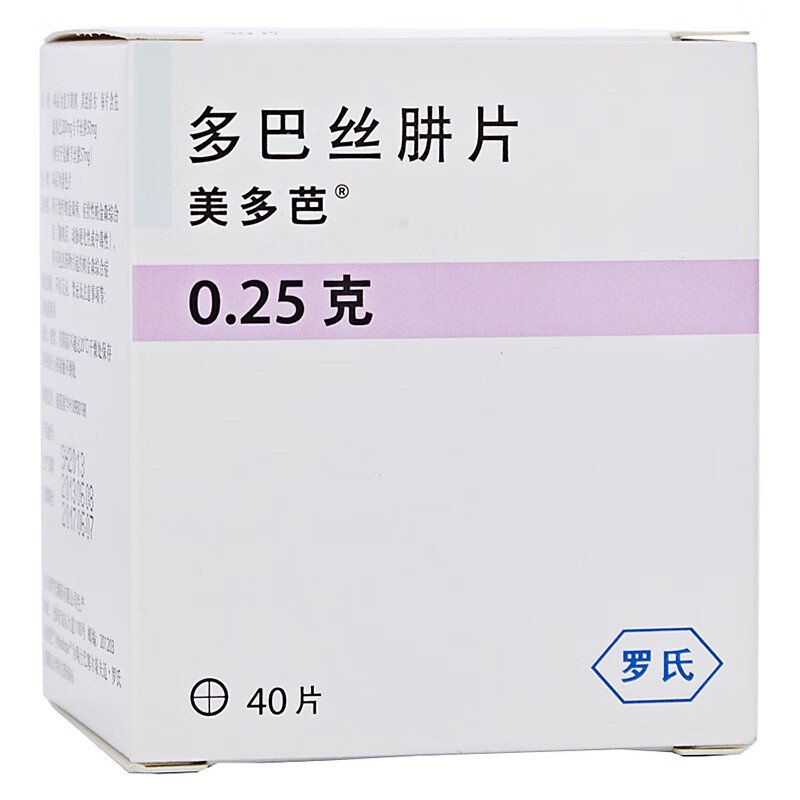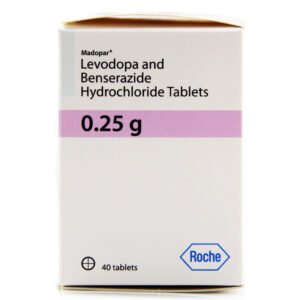Levodopa and Benserazide Hydrochloride Tablets.
Effects and efficacy: Mainly used to treat Parkinson’s disease, symptomatic Parkinson’s syndrome (post-encephalitis, arteriosclerosis or toxicity), but does not include drug-induced Parkinson’s syndrome. Usage and dosage: The most suitable daily dosage of this product must be determined according to the conditions of different patients. Please follow the doctor’s advice for details. The first recommended dosage of this product for initial treatment is 62.5~125mg each time, 2~3 times a day. The daily dosage will increase by 125mg per week until the appropriate amount is reached. Patients should have regular follow-up visits and increase the dosage under the guidance of a doctor. If the daily dose is increased twice a week, this product is increased by 125mg tablets each time, so that the effective dose can be reached faster. The effective dose is usually between 500~1000mg per day, taken 3~4 times a day. The daily dosage of this product rarely needs to exceed 1250mg. If it is necessary to give more than 1000mg tablets of this product per day, the dosage should be increased at monthly intervals. Please follow the doctor’s advice for details. Maintenance therapy The daily dose of this product should be divided into at least 3 times, and the average maintenance dose is 3 times a day, 250 mg each time. However, since the improvement of symptoms may fluctuate, the daily dose allocation depends on the specific situation of individual patients. Please follow the doctor’s advice for details. If the efficacy of the drug begins to fluctuate significantly (such as the “on-off” phenomenon), it can be changed to oral 62.5 mg. In principle, the daily dose does not change, and 62.5 mg of this product can be used to partially or completely replace the original allocation, but the interval should be shortened: if you originally took 125 mg of this product, you can use 62.5 mg twice to replace it. If you originally took 250 mg of this product, you can use 4 times of 62.5 mg each to replace it. For patients who used to take levodopa and now switch to dopasil hydrazine tablets, the minimum initial dose is 100 mg (in terms of levodopa), twice a day. Observe the patient closely and increase the dose if necessary. If the condition worsens, the dose can be increased in advance. The dosage schedule is the same as that for patients who have not been treated with levodopa before. Note: In a few cases, serious adverse reactions occurred at the beginning of treatment. At this time, the dose should not be further increased, and should even be reduced. However, it is rarely necessary to interrupt treatment. When the adverse reactions disappear or can be tolerated, the daily dose can be increased again, but it should be more slowly, such as increasing only 1/2 tablet of this product every 2 to 3 weeks. When the patient takes this product in excess of the usual effective dose (such as more than 3 tablets of this product per day), the interval between dose increases must be longer, because it takes a certain amount of time for the drug to achieve full therapeutic effect. Like all alternative methods, treatment with this product is also long-term. If symptoms improve after 4 weeks of treatment, this product should be continued to be taken to achieve good therapeutic effects. Sometimes it takes more than 6 months to achieve the best effect.
Adverse reactions:
Blood and lymphatic system: Hemolytic anemia, transient leukopenia and thrombocytopenia have been reported in very rare cases. Therefore, blood cells and liver and kidney function should be checked regularly when using drugs containing levodopa for long-term treatment. Metabolism and nutrition: Anorexia has been reported. Psychiatric symptoms: patients may experience agitation, anxiety, insomnia, hallucinations, delusions, and time disorientation, especially in elderly patients and patients with similar medical histories; there are also reports of dopamine dysregulation syndrome. Individual cases of the nervous system have reported loss of taste or taste disorders. In the late stage of treatment, dyskinesias (such as chorea-like movements or athetosis) may occur, and reducing the dosage can usually eliminate or tolerate the symptoms. As the treatment time increases, fluctuations in treatment response may also occur, including freezing attacks, end-of-dose deterioration, and “on-off” phenomena. Usually, they can be eliminated or tolerated by adjusting the dose or giving small amounts of multiple doses, and then the dose can be gradually increased to enhance the efficacy. Taking this product is associated with drowsiness, and in rare cases, it is associated with excessive daytime sleepiness or sudden sleep attacks. Cardiovascular system: Occasionally, arrhythmias and orthostatic hypotension are seen. Reducing the dose usually improves the symptoms of orthostatic hypotension. Gastrointestinal tract: Nausea, vomiting, and diarrhea can be seen. Gastrointestinal adverse reactions mainly occur in the initial stage of treatment and can be basically controlled by taking it with food or drink or slowly increasing the dose. Skin and subcutaneous tissue: Rare skin allergic reactions such as itching and rash. Interference with test results: Transient increases in liver transaminases and alkaline phosphatase may occur after medication, and there have been reports of elevated γ-glutamyl transferase. There have been reports of increased blood urea nitrogen during the use of this product. Visible changes in urine color, usually light red, darker after standing. Other body fluids or tissues, including saliva, tongue, teeth, and oral mucosa, may also become lighter or darker in color. In addition, there have been case reports of patients abroad using dopamine receptor agonists to treat Parkinson’s disease and developing pathological gambling, increased libido, and hypersexuality, especially at high doses, which are generally reversible after reducing the therapeutic dose or stopping the drug.
Drug contraindications:
Contraindicated for allergic reactions to this product Contraindicated during pregnancy Contraindicated during lactation Contraindicated for children
Share:
Products
Our offers
Health Classification
Let us work together to protect precious health
































